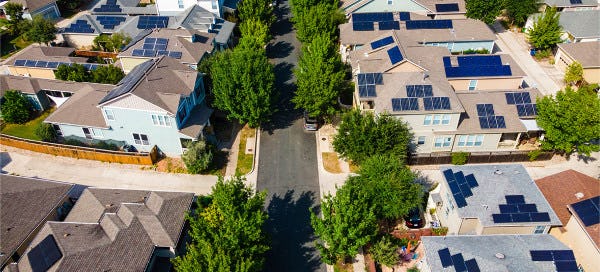A solar power system is designed to capture the sun's rays and convert them into electric or thermal energy.
The PV system that the vast majority of Texas homes use is equipped with photovoltaic cells that convert the sun's energy into usable electricity. The solar power system panels can be installed on your roof or the ground if your property includes enough open land.
The number of solar panels each home needs will vary, depending on the size of the home and the household's energy consumption needs. In general, a typical residence will need a system capable of handling as little as 5 kilowatts and as much as 20 kilowatts of energy.
When you're considering if the solar system size you'll need will be worthwhile, it will benefit you to learn more about the costs and savings related to solar energy.
What to Know About Solar Power Startup Costs
When solar energy was first introduced to the general public, the cost of a system was extremely high, making it a choice that only a small segment of homeowners could consider.
Over the years, the cost of solar panels has dropped by 60%. These costs are still continuing to drop, encouraging more Texas homeowners to seriously consider installing solar panels on or around their homes.
Another incentive to invest in solar power involves the tax breaks they may be eligible to receive from Texas and the federal government. Some cities also offer tax incentives for installing and maintaining a solar energy system.
Before investing in solar panels, contact your local and state government to discover what incentives are available to you. There may be more solar savings available in your community.
The U.S. government offers the same federal tax credit to every homeowner. Under the Investment Tax Credit or ITC, homeowners can deduct 26% of the cost of installing a solar energy system when they file their federal income taxes for that year.
However, interested homeowners should act quickly. The federal tax credit drops to 22% in 2023 and will no longer be available in 2024.
You can also get more solar savings with deals from solar system providers. For example, Rhythm offers aBuyback Plan that helps homeowners save from the beginning.
How Much Does It Cost to Operate Your Solar System?
Even with solar tax incentives and the dropping prices for the equipment, some homeowners still feel uncertain about switching to solar power. They're not sure they really will save on their monthly energy costs.
To address this concern, look at your energy bills and compare them to the $2.58 per watt cost of operating a 5 kWh system. You'll find that solar power is considerably lower.
When you calculate those savings, you'll find that the system will typically pay for itself within seven years through consistent solar energy production. You'll also generate an average lifetime savings of $84,486.
You may be able to maximize your energy savings by installing batteries to collect and store your solar energy. Since the system can only generate electricity during daylight hours when the sun is visible, you might be left without power on stormy days and in the evenings.
A bank of batteries will collect and store excess solar power during the day, allowing you to use those reserves at night. Homes that don't use batteries to store energy will still have to use electricity from the grid.
How Can You Calculate Your Solar Energy Savings?
It can be difficult to estimate the savings you'll enjoy over a long period of time with your solar power system. That's because the environment, weather conditions, and other factors can affect the quality of the panels.
You can minimize the damage to your panels by following the manufacturer's care and maintenance instructions, but you should still be aware that the environment plays a role.
Another factor to consider is the cost of energy from nonrenewable sources. In other words, what would you be paying to provide you with the same amount of clean electricity each month?
Several studies have concluded that the cost of electricity has risen by 3% annually over the past ten years. In the 2021-2022 year, the cost of electricity for residential homeowners rose by 1.3%.
Calculate Your Household's Daily Energy Consumption
When you want to accurately calculate the savings you'll enjoy with new solar panels, you'll need to know your daily energy consumption. You will also need to refer to your monthly electric bill and the solar system you intend to install to determine the cost per kilowatt-hour for each option.
You'll need a calculator to get these values, but this method will give you a more accurate answer.
First, look at the number of kilowatt-hours consumed for the billing period and divide that by the number of days in the month.
For an even more accurate sum, add up your monthly kilowatt-hours for the entire year and divide that number by 365. This will ensure you account for seasons during which you use more electricity.
You should also be aware that the solar system calculates energy production differently than your local power company. Energy production is calculated according to the maximum kilowatts the system can produce in an hour.
Most systems produce 2 kWh per hour. If your system is only exposed to sunlight for five hours per day, the maximum amount of energy produced per day is 10 kWh. Use the calculator on Rhythm's site to help understand how much a solar system would generate in your area. Try different sized solar arrays to determine how to maximize your savings.
An average home draws and uses roughly 30 kWh per day, so you may only be producing a third of the energy your household needs each day. Before installing your system, make sure it will supply you with enough electricity to meet your full needs each month. Usually, this means upgrading to a $4 per kWh system.
This type of upgrade can cost up to $16,000 per kWh when you consider the control system, batteries, and other components that will need to be included in the installation. The 2 kWh system will cost an average of $9,000.
Your next step is to figure out the cost per kilowatt-hour. This is where you'll need to know the minimum daily output of your system. Multiply the daily output by 365 to arrive at the annual output for the system.
You can discover the output of the system's life by multiplying the annual output by 25, which is the average lifetime of a solar energy system.
Divide the lifetime energy output by the cost of your system. If your 4 kWh system costs a total of $36,000, your system will cost $0.165 per kilowatt-hour to operate. Compare that sum to the cost per kilowatt-hour your electric company is charging you. This will tell you how much you're saving on your electricity bills.
Sunlight is a crucial factor in considering how much you'll save with solar panels, which is why the position of your panels is important to consider. More hours of sunlight will increase your overall energy savings.
The previous examples were based on five hours of sunlight. If your panels are exposed to sunlight for six or seven hours, that increases the amount of energy your system can generate.
Why You Should Oversize Your System
Most solar system installation contractors will provide a quote for a slightly larger system than that which will meet your needs. Installing more panels and oversizing your inverter will solve a few common problems with residential solar panel systems.
If your Texas contractor hasn't discussed oversizing your system with you, ask them about the option.
Energy Loss
It's natural to experience energy loss through natural means, so a 5 kWh system won't necessarily deliver the full 5 kWh of power. The sun might duck behind some clouds, or a storm may reduce the number of hours of sunlight.
Upgrading to a 6.5 kWh system will address those issues and ensure you get a minimum of 5 kWh.
Limitations on Inverter Sizes
Some regions limit the size of the inverter you can install. For example, a 5 kWh system will be restricted to an inverter that can only handle 5 kWh. However, if you upgrade your system and install batteries for electricity storage, you can install an inverter capable of handling more energy.
Get a Better Tax Break
Finally, consider your installation costs and your year-end tax incentives. You can save more on your income taxes by installing more panels and getting a larger inverter. While you should never oversize by more than 30%, a larger system that can handle up to that limit will help you save that much more on your taxes.
You'll also provide your household with the extra energy you might need at night or on cloudy days.
Should You Export Your Excess Solar Power?
Rather than storing excess energy for future use, some homeowners export their extra solar energy to their power company. This is another decision that will affect your energy savings, so you should find out more about what the power company offers. Rhythm's solar buyback options give customers a way to sell back the electricity they don't use.
Essentially, you'll be selling them electricity. If they aren't offering a fair price, you might be better off saving that extra electricity for yourself.
What is a fair price? Before you contact your power company, look at your utility bills to determine how much they charge you for the energy you use. If the city's electric company offers you a competitive price, it may even be worthwhile to install a bigger system that will generate more excess energy.
If the energy company is offering far less than what you pay them for electricity, you're better off trying to meet your own household's needs. You'll probably save more than you would earn by exporting your unused energy.
Consider Your Plans for an Electric Vehicle
If you own an electric vehicle or plan to buy one, you might want to install an EV charger on your property. When you're considering your household's energy usage, consider how much the charger will add to your overall consumption. When figuring out how large of a solar panel system your home will require, you should calculate that additional energy usage.
The ability to charge your electric vehicles at home will save you time and money. This is an added convenience that a slightly larger solar system will provide. Rather than waiting at a charging station, you can charge your vehicle as you relax at home.
Who Can Save with Solar Energy?
If you rent a home or apartment, your options for going solar may be limited. Talk to the property owner about installing a solar system. They may be open to the idea if it means saving on their taxes. Otherwise, you may not be able to install panels until you buy your own property.
If you are a homeowner, there's a good chance that installing solar panels may save you money. You'll need to factor in your energy consumption and the size of the system to determine how long it will take you to pay for the system with your energy savings.
Depending on the size of your household, a smaller and less expensive system may be sufficient.
Once your total system cost has been paid off, you'll enjoy free energy every month. That's when the savings will really start to pile up.
If you're considering installing a solar panel system, contact Rhythm today. We provide honest and straightforward information so that you can make a well-informed decision. You can learn more about our renewable energy plans or our Rooftop Solar Buyback plan when visiting us online.




